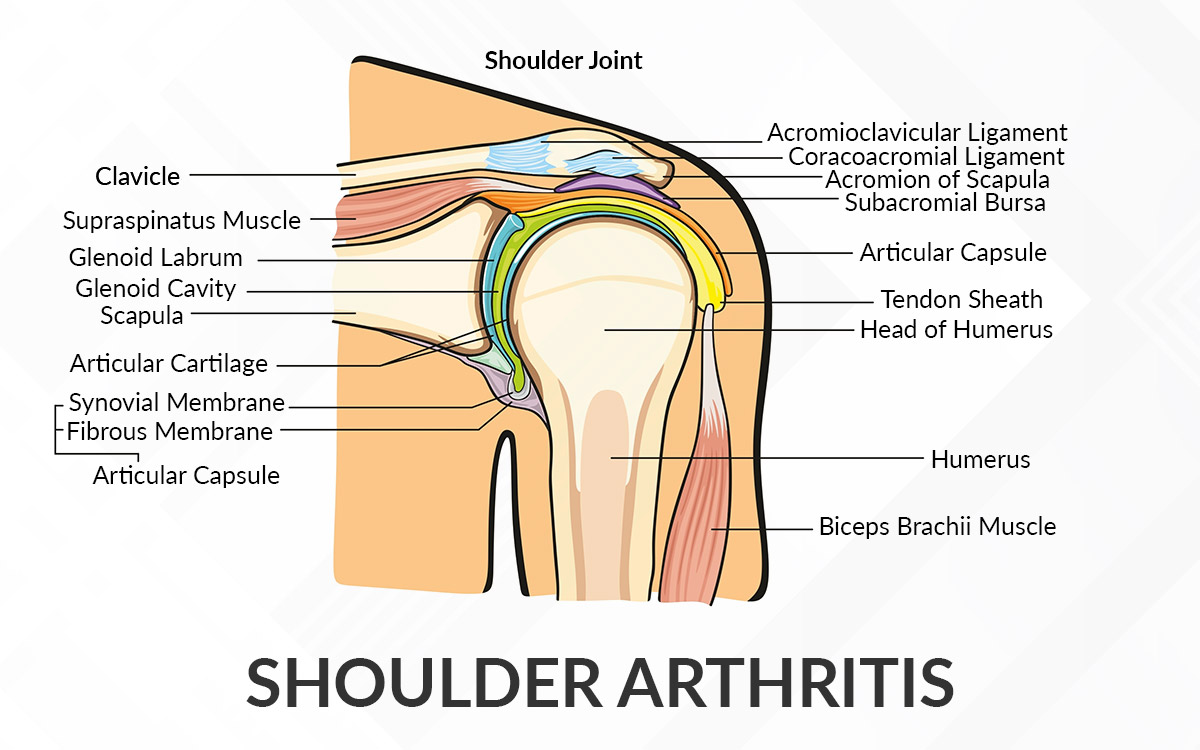
Summary
Cause
Wear and tear of cartilage of the shoulder joint
Symptoms
- Pain
- Stiffness
- Reduced range of motion
Investigations may include
- X-ray
- Ultrasound scan
- CT scan
- MRI scan
Treatment
- Non-operative
- Physiotherapy
- Analgesic medications
- Steroid injections
- Surgery
- Keyhole surgery
- Shoulder joint replacement which may include a hemiarthroplasty, a total shoulder arthroplasty
- Reverse total shoulder replacement
Shoulder arthritis occurs when the cartilage starts wearing down on the ball and/or the socket sides of the shoulder joint. Symptoms of shoulder arthritis may include pain, stiffness, and reduced range of motion.
There are five main types of arthritis that can affect your shoulder.
Osteoarthritis
Osteoarthritis or degenerative joint disease is the most common type of shoulder arthritis. In this condition, the smooth cartilage that covers the ends of bones gets worn away causing the rough bone ends to rub against each other.
It can affect the glenohumeral joint (main joint that provides most of the shoulder motion is a ball and socket joint called the glenohumeral joint) or it can affect the acromioclavicular joint (joint that connects the collar bone and the scapula).
It is generally seen in people over 50 years of age. The most common symptoms are pain, loss of motion, sometimes grinding and crepitus on movement to the shoulder. Treatment usually involves activity modification, steroid injections and finally a joint replacement. Joint replacement is an operation where the arthritic surfaces of the ball and socket are replaced with metal and plastic.
Rheumatoid Arthritis
Rheumatoid arthritis is a chronic disease which attacks multiple joints throughout the body. Joints of your body are covered by a lining called synovium that lubricates the joint and makes it easier to move. Rheumatoid arthritis causes this lining to swell which in turn causes pain, destruction, and stiffness to the joints. It is symmetrical in nature i.e. it affects the same joint on both sides of the body.
Rheumatoid arthritis is an autoimmune disease which means the immune system attacks its
own tissues, like cartilage, ligaments etc. in your joints.
Symptoms of RA include –
- Tenderness and warmth in your joints especially in your fingers
- Stiff feeling in your shoulders, elbow, fingers etc especially in the morning
- Rheumatoid nodules which are bumps under your skin in your shoulders and arms
- Feeling of fatigue, weight loss or fever
If you experience these symptoms, please contact your doctor immediately. He will take a history, do examination, order investigations and make a treatment plan for you.
Post Traumatic Arthritis
You may develop a form of arthritis called as post traumatic arthritis if you were injured.
Injuries such as a shoulder fracture dislocation playing sports or in a road traffic accident can eventually result in post-traumatic arthritis.
Avascular Necrosis (AVN)
Avascular necrosis can result in shoulder arthritis by destroying the bone and the joint tissues in your shoulder. Avascular necrosis essentially means blood cannot reach your humerus bone (upper arm bone). This can then cause cells in your shoulder bone to die. This will then result in the collapse of your upper shoulder bone and cause arthritis.
Avascular necrosis happens in patients with sickle cell disease, patients taking steroids at high doses, drinking too much alcohol or as a result of injuries like shoulder fracture dislocations and fractures.
AVN is a progressive disease meaning it will worsen with time. It can gradually evolve from asymptomatic disease to mild pain and eventually to severe pain secondary to collapse of ball and socket and arthritis.
Rotator Cuff Arthropathy
The shoulder contains a rotator cuff (four muscle and tendons) which connects the shoulder blade with the top of your arm bone through a collection of muscles and tendons.
If rotator cuff tendons get torn either secondary to injury or more commonly because of wear and tear it can lead to a form of shoulder arthritis known as rotator cuff arthropathy. Eventually the upper arm bone migrates up, ripping the tendons and eventually may cause arthritis in your shoulder as the cartilage gets eroded away.
Symptoms can include pain, muscle weakness that can make lifting overhead difficult. Eventually you may not be able to lift the arm away from the side.
What will a doctor do in the clinic?
If you experience any of the above symptoms please see your doctor immediately. Your doctor will take a medical history and do a physical examination to your shoulder.
They then may order investigations like x-ray, ultrasound scan, CT scan or an MRI scan to look at the rotator cuff tendons, the ball and socket in your shoulder. Based on that, they will make a management plan with you.
Treatment may be non-operative which will involve physiotherapy, analgesic medications, steroid injections or you may be offered surgery like keyhole surgery, shoulder joint replacement which may include a hemiarthroplasty, a total shoulder arthroplasty or a reverse total shoulder replacement.
BMI Chelsfield Park Hospital
Bucks Cross Road Chelsfield ORPINGTON BR6 7RG
01689 877855
BMI The Blackheath Hospital
40-42 Lee Terrace Blackheath LONDON SE3 9UD
020 8318 7722
BMI The Sloane Hospital
125 Albemarle Road BECKENHAM BR3 5HS
020 8466 4000
Princess Royal University Hospital
Farnborough Common ORPINGTON BR6 8ND
01689 863223




